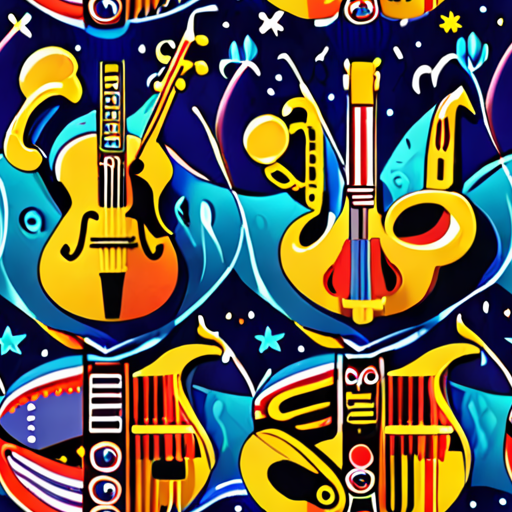Artistic music culture has long been a universal language, transcending geographical boundaries and speaking directly to the hearts of people from diverse backgrounds. This rich tapestry of sound is woven from the threads of tradition, innovation, and creativity, reflecting the unique cultural identities of societies around the world. From the haunting melodies of indigenous folk songs to the vibrant rhythms of urban hip-hop, music has played a vital role in shaping and expressing the collective heritage of human experience.

Artistic Expression Through Music Shapes and Reflects Unique Cultural Identities
As a fan of indie music, I’ve always been fascinated by how artistic expression through music shapes and reflects the unique cultural identities of diverse societies.
- The harmony of heritage: Music has the power to bring people together, transcending borders and cultures, yet it also has the ability to reflect the distinct soul and heritage of each community.
- Cultural fusion: Music often blends traditional and modern styles, creating a unique sound that represents the cultural melting pot of a society.
- Storytelling through lyrics: Songs can tell stories that capture the essence of a culture, its struggles, triumphs, and values, making music a powerful tool for preserving cultural heritage.
- Diversity in music genres: Different cultures have their own distinct music genres, each with its own history, instruments, and rhythms, reflecting the diversity of human expression.
Indie Music Scene and Cultural Identity
As a fan of indie music, I’m drawn to the creativity and authenticity of artists who push boundaries and challenge conventional norms.
- Republic of Wolves: Our website is dedicated to exploring the world of indie music, featuring interviews, reviews, and analysis of emerging artists and bands.
- Community engagement: We believe that music has the power to unite people and foster a sense of belonging, which is why we encourage our readers to share their thoughts and opinions on the music they love.
- Musical evolution: Indie music is constantly evolving, incorporating new sounds, styles, and themes, reflecting the changing landscape of contemporary culture.
- Cross-cultural exchange: The indie music scene is characterized by cross-cultural exchange, with artists drawing inspiration from diverse musical traditions and influences.
Preserving Cultural Heritage Through Music
Music has the power to preserve cultural heritage, passing down traditions, customs, and values from one generation to the next.
- Oral tradition: Music has long been an integral part of oral tradition, with songs and stories serving as a means of passing down cultural knowledge and history.
- Instrumental significance: Traditional instruments hold significant cultural importance, representing the history and identity of a particular region or community.
- Songs as historical records: Music can serve as a historical record, capturing the events, struggles, and triumphs of a culture, providing valuable insight into the past.
- Cultural revitalization: Music can play a crucial role in revitalizing cultural heritage, inspiring young people to learn about and appreciate their cultural roots.
Preserving Cultural Heritage Through Traditional Musical Instruments
Traditional musical instruments play a vital role in preserving and showcasing the rich cultural heritage of communities worldwide. These instruments have been passed down through generations, serving as a connection to our collective past and a symbol of our unique cultural identities. By exploring the significance of traditional instruments, we can gain a deeper understanding of the diverse musical traditions that shape our world.
The Importance of Traditional Instruments
Traditional instruments are more than just tools for making music – they hold deep cultural and historical significance. Each instrument has its own distinct sound, style, and history, reflecting the values, customs, and experiences of the community that created it. From the haunting melodies of the Celtic fiddle to the rhythmic beats of African drums, these instruments evoke emotions, tell stories, and bring people together.
Cultural Significance and Preservation
As cultural ambassadors, traditional instruments bridge the gap between past and present, allowing us to appreciate the evolution of music and its impact on society. They also serve as a reminder of the importance of preserving cultural heritage, which is often threatened by globalization and urbanization. By learning about and appreciating traditional instruments, we can work towards preserving the cultural diversity that makes our world a richer and more interesting place.
Examples of Traditional Instruments
- The Sitar: A stringed instrument originating from India, known for its distinctive sound and intricate playing techniques.
- The Kora: A West African harp-like instrument played with the hands, used in various traditional music styles.
- The Shamisen: A Japanese lute-like instrument with three strings, often used in traditional folk music.
- The Guqin: An ancient Chinese zither with seven strings, considered one of the oldest known musical instruments.
Connecting Communities Through Music
Traditional instruments have the power to unite people across cultures, languages, and geographical boundaries. By sharing and celebrating our musical heritage, we can foster greater understanding, empathy, and cooperation among nations. Whether through festivals, concerts, or educational programs, traditional instruments offer a unique opportunity to promote cross-cultural exchange and appreciation.
Conclusion
Traditional musical instruments are a vital part of our cultural identity, holding significant emotional, social, and historical value. By embracing and preserving these instruments, we can honor our heritage, promote cultural diversity, and enrich our lives with the beauty and richness of traditional music.
Unlocking the Power of Artistic Music Culture
As a fan of indie music, I’m constantly fascinated by the ways in which artistic music intersects with culture to create something truly unique and meaningful.
- The intersection of artistic music and culture reveals the rich tapestry of global traditions and the profound impact of music on our shared human experience.
- By exploring the connections between music and culture, we can gain a deeper appreciation for the diversity and richness of global traditions.
- This fusion of art and culture has the power to bridge borders, bringing people together and fostering a sense of community and understanding.
Exploring the World of Indie Music
As a fan of indie music, I’ve had the opportunity to delve into the world of Republic of Wolves, a website dedicated to fans of indie music.
- Republic of Wolves offers insights into the band’s creative process, live performances, and the broader indie music scene.
- The website provides blog content that delves into the artistic journey of the band, updates on indie music trends, and reflections on creative expression.
- Designed to connect and inspire indie music enthusiasts, Republic of Wolves serves as a hub for fans to explore stories behind the music and stay updated on band activities and music culture.
Celebrating Diversity and Richness
When it comes to celebrating diversity and richness in global traditions, there are many amazing artists and bands worth exploring.
- One of my favorite bands is Bon Iver, known for their ethereal soundscapes and poignant lyrics that capture the essence of the human experience.
- Another standout artist is St. Vincent, who seamlessly blends indie rock with electronic and pop elements to create a unique sound that’s both catchy and thought-provoking.
- These artists, along with many others, demonstrate the incredible diversity and richness of global traditions and the power of music to bring people together.
Navigating the Intersection of Art and Culture
So how can we navigate the complex intersection of art and culture to gain a deeper appreciation for the diversity and richness of global traditions?
- Start by exploring different genres of music and learning about the cultural contexts in which they emerged.
- Attend concerts and festivals to experience the energy and excitement of live music firsthand.
- Engage with online communities and forums to discuss music and culture with fellow fans and enthusiasts.
Embracing the Beauty of Cultural Exchange
Ultimately, embracing the beauty of cultural exchange requires an open mind, a willingness to learn, and a deep appreciation for the diversity and richness of global traditions.
By exploring the intersection of artistic music and culture, we can gain a deeper understanding of ourselves and the world around us, and cultivate a greater sense of empathy and compassion for others.

Breaking Down Barriers with Diverse Artistic Music Cultures
Exposure to various artistic music cultures has the power to broaden our perspectives and foster empathy across international boundaries.
- The Power of Music as a Universal Language
- Fostering Empathy Through Shared Experiences
- Bridging Cultural Divides
- Unlocking New Perspectives
Music has a unique ability to transcend linguistic and cultural barriers, allowing people from different backgrounds to connect and understand each other on a deeper level.
When we expose ourselves to diverse musical styles and genres, we gain insight into the experiences and emotions of others, promoting empathy and compassion.
Artistic music cultures have the potential to bridge cultural divides, encouraging cross-cultural exchange and collaboration.
Exploring diverse musical traditions can broaden our perspectives, challenging our assumptions and fostering a greater appreciation for the complexities of human experience.
Real-Life Examples of Music’s Impact
From the jazz clubs of New Orleans to the folk festivals of Scandinavia, music has played a significant role in shaping cultural identity and promoting cross-cultural understanding.
- The Role of Music in Social Justice Movements
- Musical Collaborations Across Borders
Music has long been a powerful tool for social justice movements, providing a platform for marginalized voices and inspiring collective action.
Cross-cultural collaborations in music have led to innovative and groundbreaking works, pushing the boundaries of artistic expression and promoting mutual understanding.
Getting Involved in Your Local Music Scene
To experience the transformative power of artistic music cultures firsthand, get involved in your local music scene by attending concerts, joining music groups, or volunteering at music-related events.
By embracing diversity and exploring the rich tapestry of global music cultures, we can cultivate a deeper sense of empathy and understanding, ultimately breaking down barriers and building bridges between communities.
Exploring Cultural Identity Through Music
Music has long been a universal language, capable of bridging cultural divides and bringing people together in a shared experience. From traditional folk songs to modern electronic beats, music plays a vital role in expressing and celebrating cultural identity across various societies around the world. In this article, we’ll delve into the key similarities and differences between the ways music is used to express and celebrate cultural identity globally.
Cultural Significance of Music
Music holds immense cultural significance, serving as a means of preserving history, passing down traditions, and fostering community bonding. In many cultures, music is an integral part of daily life, accompanying important events, rituals, and ceremonies. For instance, in African cultures, music is often used during initiation rites, weddings, and funerals, while in Indian classical music, ragas are used to evoke emotions and tell stories.
Diverse Musical Expressions
From the soulful melodies of African-American blues to the energetic rhythms of Latin American salsa, music takes on various forms and styles across cultures. Each genre reflects the unique experiences, values, and histories of its respective society, making music a powerful tool for self-expression and cultural representation. For example, in Japan, traditional instruments like the shamisen and koto are used to play complex melodies, while in India, the sitar and tabla are used to create intricate rhythmic patterns.
Similarities in Music Expression
Despite the diversity of musical styles, there are commonalities in the ways music is used to express and celebrate cultural identity. One similarity is the use of music as a means of storytelling, whether through lyrics, instrumentation, or vocal techniques. Another similarity is the importance of music in communal gatherings, such as festivals, concerts, and ceremonies, which bring people together and reinforce social bonds.
Differences in Music Expression
While music shares commonalities across cultures, there are significant differences in the ways it is expressed and celebrated. For instance, in Western cultures, music is often associated with individualism and personal expression, whereas in many non-Western cultures, music is seen as a collective activity, emphasizing community and social harmony. Additionally, the role of technology in music production and dissemination varies greatly across cultures, with some societies embracing digital tools and others preferring traditional methods.
Global Music Exchange
In today’s interconnected world, music has become a global phenomenon, with artists and genres influencing one another across geographical boundaries. This exchange has led to the creation of new sounds, styles, and fusions, reflecting the complexities of globalization and cultural hybridity. As music continues to transcend borders and cultures, it remains a powerful force for unity, understanding, and celebration of our shared humanity.
- The use of music as a means of storytelling and cultural preservation.
- The importance of music in communal gatherings and social bonding.
- The diversity of musical styles and expressions across cultures.
- The role of technology in music production and dissemination.
- The global music exchange and its impact on cultural identity.
By exploring the similarities and differences in music expression across cultures, we can gain a deeper appreciation for the richness and diversity of human experience. Whether through traditional instruments, modern electronic beats, or fusion styles, music remains a universal language, capable of bridging cultural divides and celebrating our shared humanity.

Unraveling the Threads of Artistic Music Culture
Weaving a rich tapestry of artistic expression and cultural identity, the diverse sounds and styles of artistic music across different cultures share common threads that transcend borders and boundaries.
- The universal language of music allows artists to convey emotions, tell stories, and evoke feelings that resonate deeply with listeners worldwide.
- Cultural exchange and fusion have led to the creation of unique genres and styles, reflecting the blending of traditions and influences.
- The power of music to bring people together and foster community has been harnessed by artists and musicians across cultures, creating a shared sense of belonging and connection.
- The evolution of technology has democratized access to music-making tools and platforms, enabling artists from diverse backgrounds to reach global audiences and share their perspectives.
- The importance of preserving traditional music and cultural heritage has become increasingly recognized, with efforts underway to document, promote, and protect these valuable assets.
Exploring the Common Ground
Despite differences in style, genre, and cultural context, artistic music shares certain fundamental qualities that unite artists and listeners alike:
- A deep emotional resonance that speaks to the human experience
- A capacity to evoke powerful emotions and memories
- A role in shaping cultural identity and tradition
- A potential to bridge cultural divides and foster understanding
- A boundless creativity and innovation that pushes artistic boundaries
Conclusion
In conclusion, the common threads that connect the diverse sounds and styles of artistic music across different cultures reflect the universal language of music, the power of cultural exchange, and the importance of preserving traditional heritage.

0 Comments